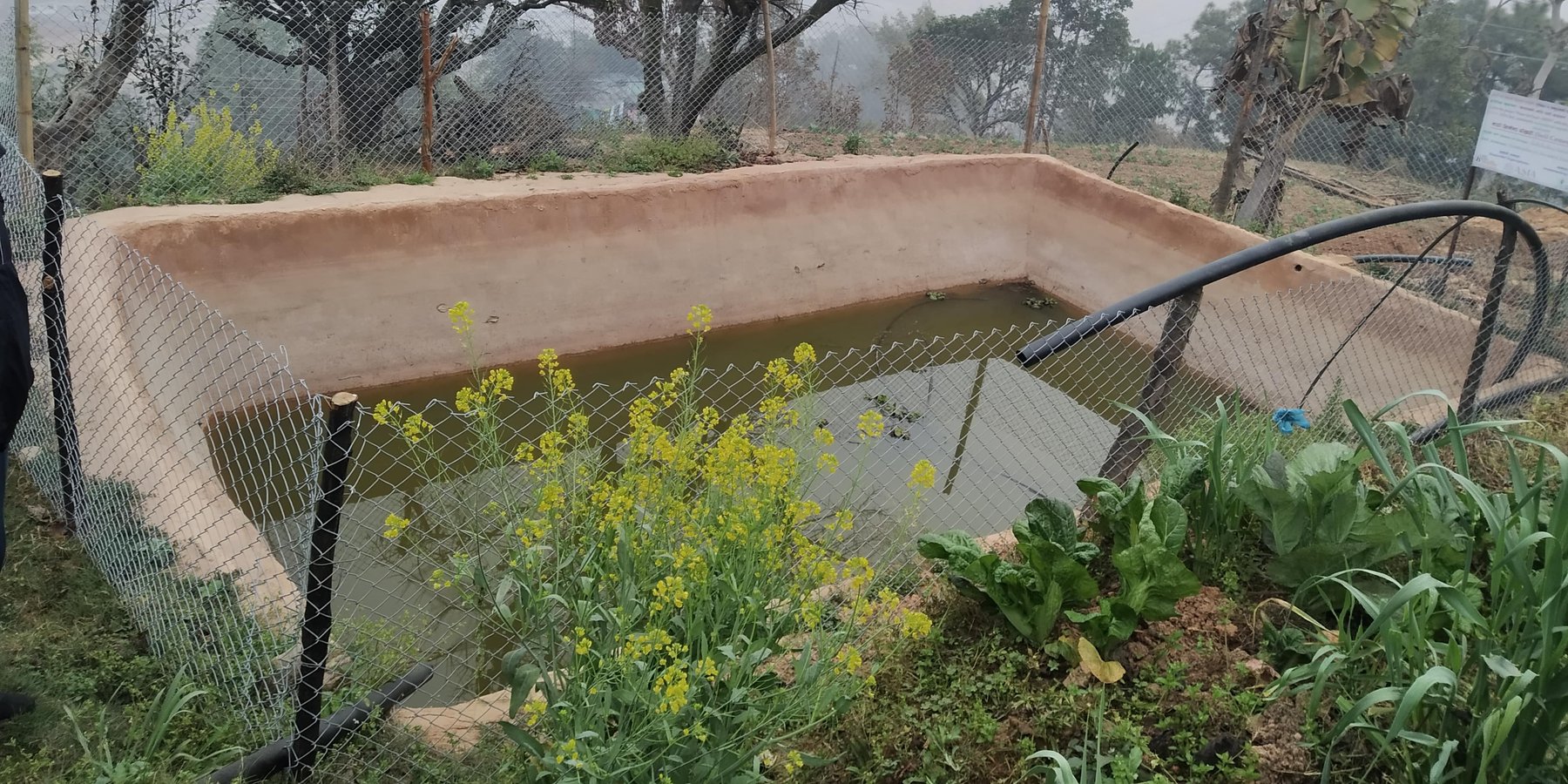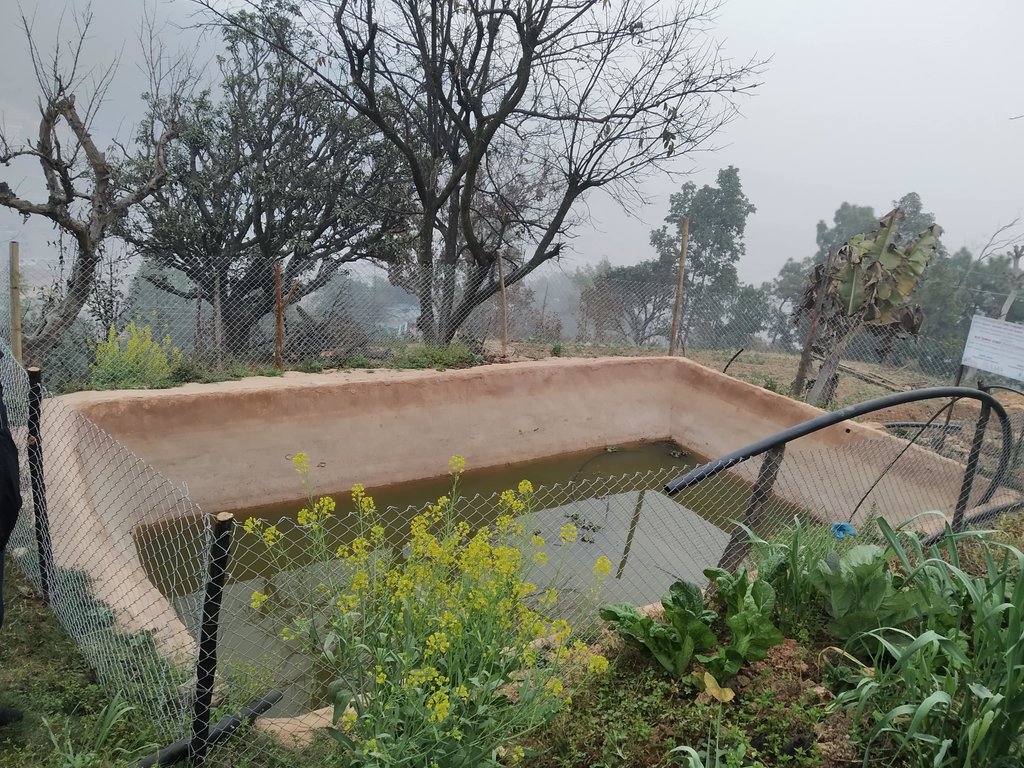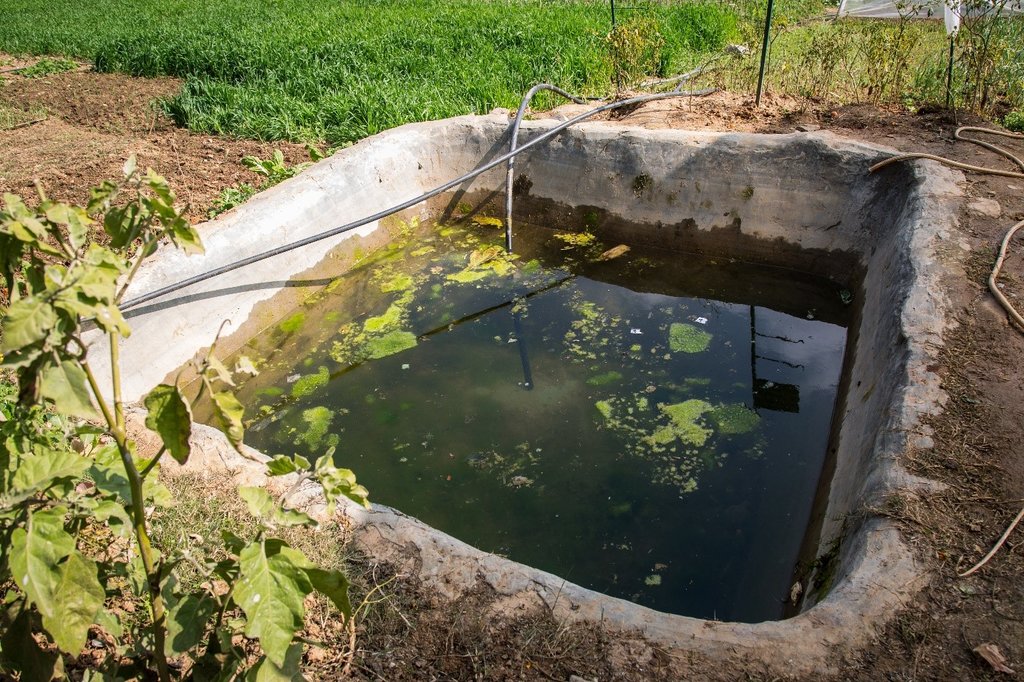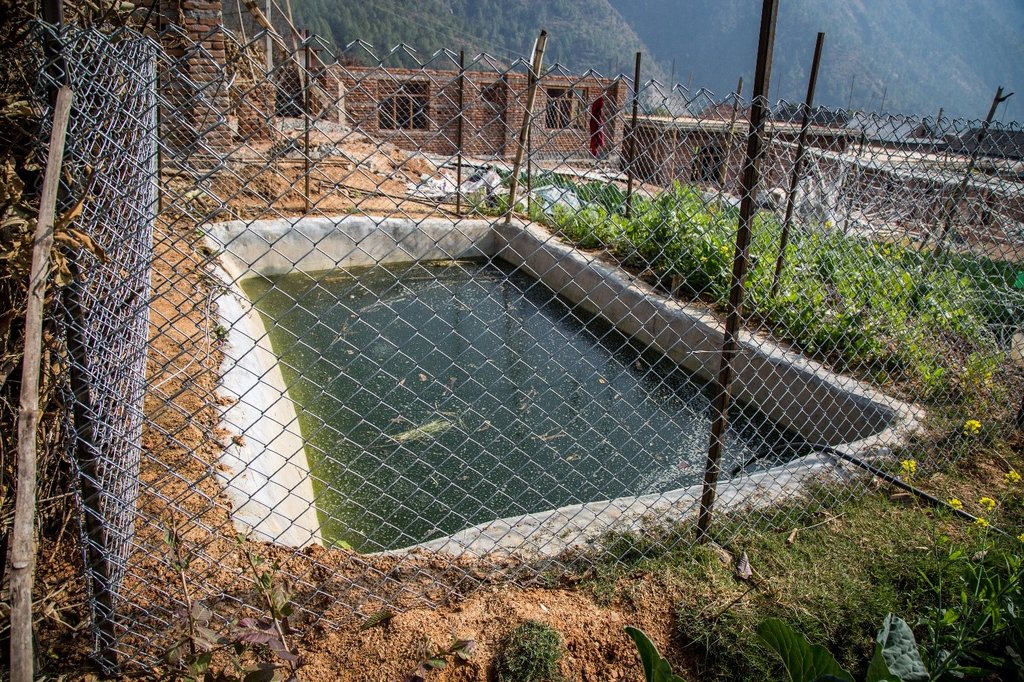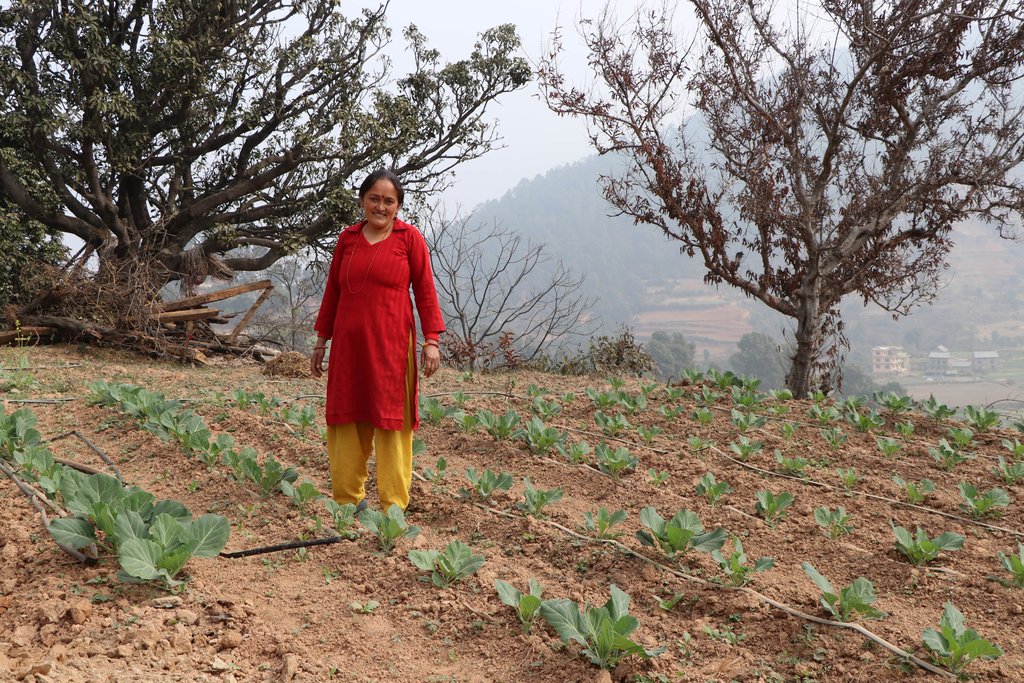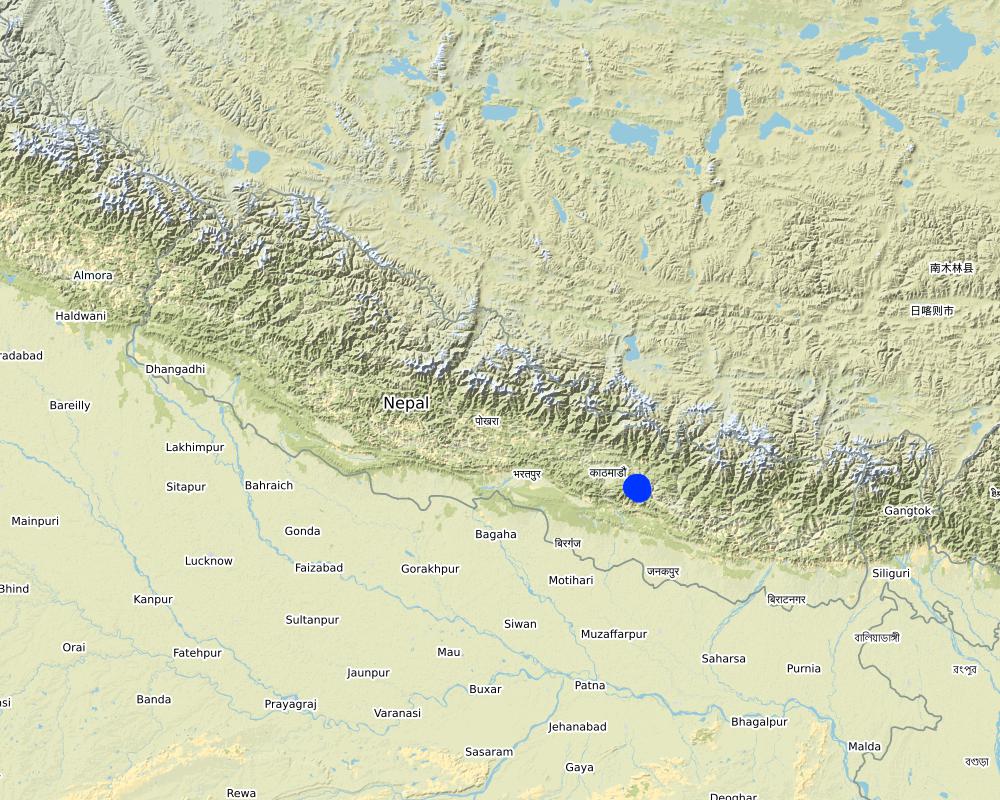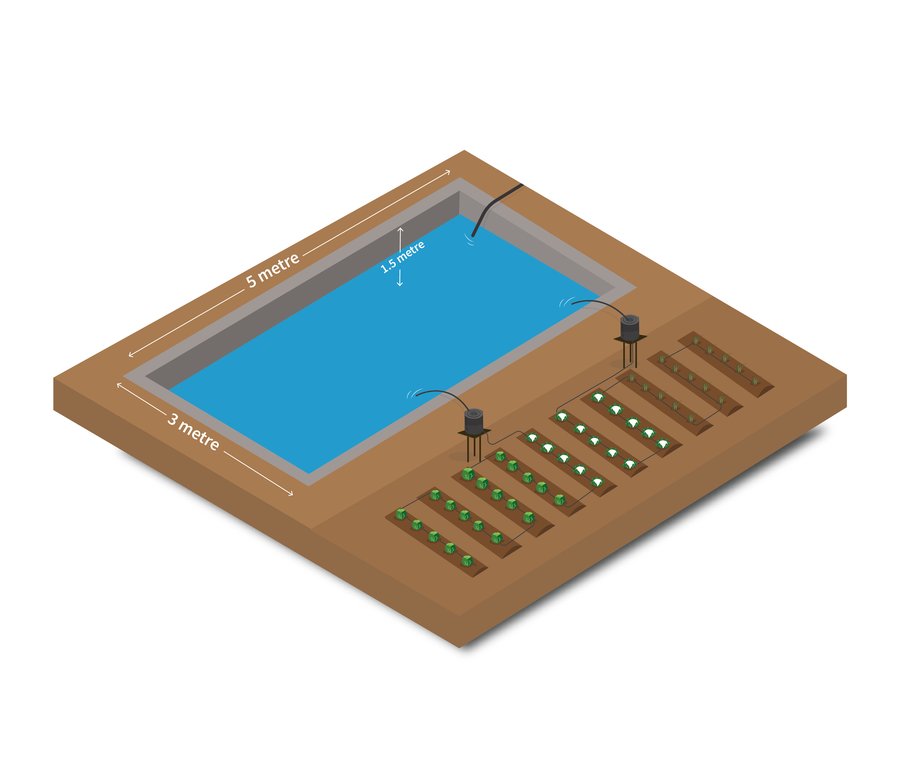Soil Cement Water Collection Pond for Supplemental Irrigation Purpose in Dry Season [Nepal]
- Creación:
- Actualización:
- Compilador: Kabita Nhemhafuki
- Editor: –
- Revisores: Rima Mekdaschi Studer, Isabelle Providoli
Mato, Baluwa ra Cement bata Nirmit Sinchai Pokhari - Nepali
technologies_5684 - Nepal
Visualizar secciones
Expandir todo Colapsar todos1. Información general
1.2 Detalles de contacto de las personas de referencia e instituciones involucradas en la evaluación y la documentación de la Tecnología
Persona(s) de referencia clave
Especialista MST:
Shah Ram Deo
The Center for Environmental and Agricultural Policy Research, Extension and Development (CEAPRED)
Nepal
usuario de la tierra:
Gautam Laxmi
Nepal
usuario de la tierra:
K.C Prashuram
Nepal
usuario de la tierra:
Neupane Kumar
Nepal
usuario de la tierra:
Adhikari Apsara
Nepal
usuario de la tierra:
Shrestha Jay Ram
Nepal
Nombre del proyecto que financió la documentación/ evaluación de la Tecnología (si fuera relevante)
Resilient Mountain Solutions Initiative, ICIMOD (RMS initiative)Nombre de la(s) institución(es) que facilitaron la documentación/ evaluación de la Tecnología (si fuera relevante)
ICIMOD International Centre for Integrated Mountain Development (ICIMOD) - Nepal1.3 Condiciones referidas al uso de datos documentados mediante WOCAT
El compilador y la/s persona(s) de referencia claves aceptan las condiciones acerca del uso de los datos documentados mediante WOCAT:
Sí
1.4 Declaración de la sostenibilidad de la Tecnología descrita
¿La Tecnología aquí descrita resulta problemática en relación a la degradación de la tierra, de tal forma que no puede considerársela una tecnología sostenible para el manejo de la tierra?
No
2. Descripción de la Tecnología MST
2.1 Breve descripción de la Tecnología
Definición de la Tecnología:
A soil cement water collection pond to store rainwater, runoff and household kitchen waste water free from soap and detergent for supplemental irrigation purpose during dry seasons.
2.2 Descripción detallada de la Tecnología
Descripción:
In Nepal's mid-hills mountain farmers face problems during dry seasons to irrigate their fields, as they entirely depend on rain- water. Soil cement water collection pond are ideal to tackle this challenge, as they can capture excess rainfall during monsoon, which is later available during prolonged seasonal water shortage.
The Resilient Mountain Village (RMV) project of ICIMOD together with its local partner, CEAPRED tested and demonstrated soil cement ponds with a capacity of 24000 liters. The conservation ponds were used for irrigating high value off-season horticultural crops (vegetables, fruit, and spices). These crops were irrigated with drip irrigation and micro sprinklers. The ponds were fed from rainwater, upland springs and taps, and household wastewater from kitchen free from soap and detergent. They were established during the dry season during 3 months. They were prepared by selecting a suitable site with a sufficient catchment; mapping out the area and depth of the pond; digging out the soil; removing protruding stones and roots; and compacting and smoothing the sides and bottom of the pond. Then gravel and pebbles were used for the base and the floor and side walls were leveled off. Initial mixture of soil, sand and cement (3:3:1) was applied to roughly plaster all the side walls and gravel was mixed in the mixture while plastering the floor. The following day, the roughly plastered pond was watered and was covered with wet jute sack to keep it moist. This was continued for 3-4 days. Then again a second mixture of soil, sand and cement (2:2:1) was applied to smoothly plaster the floor and side walls. The pond was watered for the next 3-4 days and was covered with wet jute sacks. Around 4-5 days after the second plaster, the pond was filled with water. For safety, pond was enclosed with a gabion wire/ bamboo fence (or using any locally available material). The total establishment cost for a soil cement pond with 24000 liters capacity was USD 311.
The main maintenance activity was to maintain the gabion wire/bamboo fence to prevent livestock and people from entering the pond, and to remove the sediment that accumulates in the pond. The sediment has to be removed once a year carefully by hand and if cracks occur, it should be sealed with a mixture of soil, sand and cement (3:3:1). The total annual maintenance cost for 24000 liters soil cement tank was USD 68.
This technology has somehow helped small-land holding farmers to irrigate their rain-fed land during dry months which has increased the crop production and their income as well.
Land user's particularly liked that their production increased and that they were able to grow up to three crops per year. Trough this the farmers were able to diversify their crops, and they were less vulnerable to the dry season. In addition, soil cement water ponds are more efficient than plastic-lined conservation ponds which are easily damaged by rats. Although cost effective, the fixed price for this technology is quite high, particularly for smallholder farmers. To lessen this financial burden, local governments can provide subsidies to women and marginalized groups interested in this technology. Self-help groups with a revolving grants system would help expand the use of these ponds and ensure sustained use across Nepal.
2.3 Fotografías de la Tecnología
Comentarios generales sobre las fotos:
Size of soil cement pond depends upon the area of land to be irrigated.
2.5 País/ región/ lugares donde la Tecnología fue aplicada y que se hallan comprendidos por esta evaluación
País:
Nepal
Región/ Estado/ Provincia:
Province no: 3
Especifique más el lugar :
Namobuddha Municipality, Kavrepalanchowk District, Nepal
Especifique la difusión de la Tecnología:
- aplicada en puntos específicos/ concentrada en un área pequeña
¿El/los sitio(s) de la Tecnología se ubica(n) en un área de protección permanente?
No
Map
×2.6 Fecha de la implementación
Si no se conoce el año preciso, indique la fecha aproximada:
- hace menos de 10 años (recientemente)
2.7 Introducción de la Tecnología
Especifique cómo se introdujo la Tecnología:
- mediante proyectos/ intervenciones externas
Comentarios (tipo de proyecto, etc.):
ICIMOD demonstrated this technology through the program of Resilient Mountain Village (RMV) with the help of its implementing local partner, The Center for Environmental and Agricultural Policy Research, Extension and Development (CEAPRED) in its pilot project sites in Kavrepalanchok district.
3. Clasificación de la Tecnología MST
3.1 Propósito(s) principal(es) de la Tecnología MST
- mejorar la producción
- Improve water availability during dry seasons
3.2 Tipo(s) actuales de uso de la tierra donde se aplica la Tecnología
Mezcla de tipos de uso de tierras dentro de la misma unidad de tierras: :
No

Tierras cultivadas
- Cosecha anual
Cosechas anuales - Especifique cultivos:
- cereales - maíz
- cereales - arroz (tierras altas)
- leguminosas y legumbres - frijoles
- cultivos de raíces/ tubérculos - patatas
- cultivos de semillas - sésamo, amapola, mostaza, otros
- vegetales - verdura de hojas verdes (ensaladas, repollo, espinaca, otros)
Número de temporadas de cultivo por año:
- 3
Especifique:
Longest growing period in days: 150; Longest growing period from month to month: Jun - Oct; Second longest growing period in days: 120; Second longest growing period from month to month: Nov - Feb
¿Se practica el intercultivo?
Sí
Si respondió que sí, especifique qué cultivos son intercultivados:
Tomato and raddish
¿Se practica la rotación de cultivos?
No
3.3 ¿Cambió el uso de tierras debido a la implementación de la Tecnología?
¿Cambió el uso de tierras debido a la implementación de la Tecnología?
- No (Continúe con la pregunta 3.4)
3.4 Provisión de agua
Provisión de agua para la tierra donde se aplica la Tecnología:
- de secano
3.5 Grupo MST al que pertenece la Tecnología
- cosecha de agua
- Manejo de irrigación: (incl. provisión de agua, invernaderos)
3.6 Medidas MST que componen la Tecnología

medidas estructurales
- S4: Acequias niveladas, fosas
- S7: Equipo para cosechar agua / provisión de agua/ irrigación
3.7 Principales tipos de degradación del suelo encarados con la Tecnología

degradación del agua
- Ha: aridificación
- Hs: cambio en la cantidad de aguas superficiales
3.8 Prevención, reducción o restauración de la degradación del suelo
Especifique la meta de la Tecnología con relación a la degradación de la tierra:
- reducir la degradación del suelo
4. Especificaciones técnicas, actividades de implementación, insumos y costos
4.1 Dibujo técnico de la Tecnología
Especificaciones técnicas (relacionadas al dibujo técnico):
Soil Cement Water Collection Pond for Irrigation Purpose in Dry Seasons
Location: Charange fedi, 03, Namobuddha Municipality, Kavrepalanchowk
Technical knowledge required for field staff / advisors: moderate
Technical knowledge required for land users: moderate
Main technical functions: water harvesting / increase water supply
Secondary technical functions: control of dispersed runoff: retain / trap
Structural measure: pond
Depth of ditches/pits/dams (m): 1.5
Width of ditches/pits/dams (m): 3
Length of ditches/pits/dams (m): 5
Capacity of the tank= 24000 litres.
Construction material (earth): Clay
Construction material (other): Cement, sand and water-proofing liquid
Autor:
Kabita Nhemhafuki, Ram Dev Shah
Fecha:
01/12/2020
4.2 Información general sobre el cálculo de insumos y costos
Especifique cómo se calcularon los costos e insumos:
- por área de Tecnología
Indique tamaño y unidad de área:
0.0024 ha
Si usa una unidad de área local, indique el factor de conversión a una hectárea (ej. 1 ha = 2.47 acres): 1 ha =:
1 ha = 10000 square metres
Especifique la moneda usada para calcular costos:
- USD
Indique el costo promedio del salario de trabajo contratado por día:
5.68
4.3 Actividades de establecimiento
| Actividad | Momento (estación) | |
|---|---|---|
| 1. | Select a preferably stable ground with a sufficient catchment area | dry months |
| 2. | Measure the area to be irrigated and estimate the size of the pond | dry months |
| 3. | Measure and mark out the pond | 1st day |
| 4. | Dig out the soil to the pre-determined depth and remove protruding stones and roots | 1st day |
| 5. | Compacting and smoothing the sides and bottom of the pond | 2nd day |
| 6. | Apply initial mixture of soil, sand, cement (3:3:1) to roughly plaster all the the side walls and mix gravel in the mixture while plastering the floor. | 2nd day |
| 7. | The following day, the roughly plastered pond should be watered and covered with wet jute sack to keep it moist. This should be continued for 3-4 days. | 3rd day |
| 8. | Apply a second mixture of soil, sand, and cement (2:2:1) to smoothly plaster the floor and side walls. | 5th day |
| 9. | Water the pond for the next 3-4 days and cover with wet jute sack. | 8th day |
| 10. | Around 4-5 days of second plaster, fill the pond with water. | 13th day |
| 11. | For safety, the pond can be enclosed with gabion wire/ bamboo fence (or using other locally available materials) | 14th day |
4.4 Costos e insumos necesarios para el establecimiento
| Especifique insumo | Unidad | Cantidad | Costos por unidad | Costos totales por insumo | % de los costos cubiertos por los usuarios de las tierras | |
|---|---|---|---|---|---|---|
| Mano de obra | Dig out pond | persons/unit | 7,0 | 5,68 | 39,76 | 100,0 |
| Mano de obra | Stone soiling | persons/unit | 1,0 | 8,74 | 8,74 | |
| Mano de obra | Cementing | persons/unit | 10,0 | 8,74 | 87,4 | |
| Mano de obra | Wiring | persons/unit | 2,0 | 8,74 | 17,48 | |
| Equipo | Spade | piece | 3,0 | 2,0 | 6,0 | 100,0 |
| Equipo | Measuring tape | piece | 2,0 | 1,0 | 2,0 | 100,0 |
| Equipo | Shovel | piece | 3,0 | 7,0 | 21,0 | 100,0 |
| Equipo | Hammer | piece | 3,0 | 4,0 | 12,0 | 100,0 |
| Equipo | Cement mixing iron pan | piece | 2,0 | 3,0 | 6,0 | 100,0 |
| Equipo | Trowel | piece | 3,0 | 2,0 | 6,0 | 100,0 |
| Material de construcción | Sand | bags | 24,0 | 0,87 | 20,88 | |
| Material de construcción | Cement | bags | 6,0 | 7,43 | 44,58 | |
| Material de construcción | Water proofing liquid | bottle | 1,0 | 2,62 | 2,62 | |
| Material de construcción | Gabion wire sheets | sq.ft | 120,0 | 0,31 | 37,2 | |
| Costos totales para establecer la Tecnología | 311,66 | |||||
| Costos totales para establecer la Tecnología en USD | 311,66 | |||||
Si el usuario de la tierra no cubrió el 100% de los costos, indique quién financió el resto del costo:
The Center for Environmental and Agricultural Policy Research, Extension and Development (CEAPRED) covered the remaining cost
Comentarios:
Duration of establishment phase: 3 month(s)
4.5 Actividades de establecimiento/ recurrentes
| Actividad | Momento/ frequencia | |
|---|---|---|
| 1. | Maintain and repair wire fence to prevent livestock and humans from entering the pond | once in a year |
| 2. | Removing accumulated sediment once a year carefully by hand | dry months/once in a year |
4.6 Costos e insumos necesarios para actividades de mantenimiento/ recurrentes (por año)
| Especifique insumo | Unidad | Cantidad | Costos por unidad | Costos totales por insumo | % de los costos cubiertos por los usuarios de las tierras | |
|---|---|---|---|---|---|---|
| Mano de obra | Clean and maintaining the pond | persons/unit | 3,0 | 5,68 | 17,04 | 100,0 |
| Mano de obra | Maintain and repair wire fence | persons/unit | 2,0 | 7,0 | 14,0 | 100,0 |
| Material de construcción | Gabion wire | sq.ft | 120,0 | 0,31 | 37,2 | 100,0 |
| Indique los costos totales para mantenecer la Tecnología | 68,24 | |||||
| Costos totales para mantener la Tecnología en USD | 68,24 | |||||
Comentarios:
The cost given above is for unit technology having 24000 liters capacity as in 2020.
4.7 Factores más determinantes que afectan los costos:
Describa los factores más determinantes que afectan los costos:
Cost of cement and sand
Members of a household contributed as labour in all sites.
5. Entorno natural y humano
5.1 Clima
Lluvia anual
- < 250 mm
- 251-500 mm
- 501-750 mm
- 751-1,000 mm
- 1,001-1,500 mm
- 1,501-2,000 mm
- 2,001-3,000 mm
- 3,001-4,000 mm
- > 4,000 mm
Especifique el promedio anual de lluvia (si lo conoce), en mm:
1584,00
Zona agroclimática
- húmeda
Thermal climate class: subtropics
5.2 Topografía
Pendientes en promedio:
- plana (0-2 %)
- ligera (3-5%)
- moderada (6-10%)
- ondulada (11-15%)
- accidentada (16-30%)
- empinada (31-60%)
- muy empinada (>60%)
Formaciones telúricas:
- meseta/ planicies
- cordilleras
- laderas montañosas
- laderas de cerro
- pies de monte
- fondo del valle
Zona altitudinal:
- 0-100 m s.n.m.
- 101-500 m s.n.m.
- 501-1,000 m s.n.m
- 1,001-1,500 m s.n.m
- 1,501-2,000 m s.n.m
- 2,001-2,500 m s.n.m
- 2,501-3,000 m s.n.m
- 3,001-4,000 m s.n.m
- > 4,000 m s.n.m
Indique si la Tecnología se aplica específicamente en:
- no relevante
5.3 Suelos
Profundidad promedio del suelo:
- muy superficial (0-20 cm)
- superficial (21-50 cm)
- moderadamente profunda (51-80 cm)
- profunda (81-120 cm)
- muy profunda (>120 cm)
Textura del suelo (capa arable):
- mediana (limosa)
- fina/ pesada (arcilla)
Textura del suelo (> 20 cm debajo de la superficie):
- mediana (limosa)
Materia orgánica de capa arable:
- media (1-3%)
Si se halla disponible, adjunte una descripción completa de los suelos o especifique la información disponible, por ej., tipo de suelo, pH/ acidez de suelo, capacidad de intercambio catiónico, nitrógeno, salinidad, etc. :
Soil fertility is medium
Soil drainage / infiltration is good
Soil water storage capacity is medium
5.4 Disponibilidad y calidad de agua
Agua subterránea:
5-50 m
Disponibilidad de aguas superficiales:
mediana
Calidad de agua (sin tratar):
agua potable de mala calidad (requiere tratamiento)
La calidad de agua se refiere a:
agua subterránea y superficial
¿La salinidad del agua es un problema?
No
¿Se está llevando a cabo la inundación del área? :
No
Comentarios y especificaciones adicionales sobre calidad y cantidad de agua:
Water source is mainly spring.
More in rainy season (June- September), less in April/May; source: spring
5.5 Biodiversidad
Diversidad de especies:
- elevada
Diversidad de hábitats:
- elevada
Comentarios y especificaciones adicionales sobre biodiversidad:
Nepal harbors 3.2 % and 1.1 % world's known flora and fauna respectively despite occupying only 0.1 % of global area. Particularly, beta diversity is high in Nepal (BCN and DNPWC, 2011).
5.6 Las características de los usuarios de la tierra que aplican la Tecnología
Sedentario o nómada:
- Sedentario
Orientación del mercado del sistema de producción:
- mixta (subsistencia/ comercial)
Ingresos no agrarios:
- 10-50% de todo el ingreso
Nivel relativo de riqueza:
- pobre
- promedio
Individuos o grupos:
- individual/ doméstico
Nivel de mecanización:
- trabajo manual
- tracción animal
Género:
- mujeres
- hombres
Edad de los usuarios de la tierra:
- personas de mediana edad
Indique otras características relevantes de los usuarios de las tierras:
Land users applying the Technology are mainly common / average land users
Population density: 154 - 453 persons per km2 ( Census, 2011)
Annual population growth : 2% - 3%
Among 100% land users, 80% of the land users are average wealthy and own 90% of the land (ranked by land users). 20% of the land users are poor and own 10% of the land.
Off-farm income specification:
Occasional opportunities for off-farm income present themselves in the form of daily labour wages.
Due to loss of farmland and increasing urbanization and loss of farmlands many people are switching from agriculture to non-farm occupations such as working in brick kilns.
The opening of the BP Highway has led to the establishment of many hotels and restaurants and the development of local market places such as Bhakundebesi.
Most local businesspersons are small entrepreneurs with limited investment capacity.
Some households’ members receive regular salaries, whilst an increasing number of Nepalis are working in India, the Middle East, Malaysia, and elsewhere and sending remittance incomes home.
Market orientation of production system: Vegetables- commercial
Level of mechanization: Manual labor consists of planting, irrigation , harvesting, while field preparation is carried out by animals, also machines but just in valley bottom.
5.7 Área promedio de la tierra usada por usuarios de tierra que aplican la Tecnología
- < 0.5 ha
- 0.5-1 ha
- 1-2 ha
- 2-5 ha
- 5-15 ha
- 15-50 ha
- 50-100 ha
- 100-500 ha
- 500-1,000 ha
- 1,000-10,000 ha
- > 10,000 ha
¿Esto se considera de pequeña, mediana o gran escala (refiriéndose al contexto local)?
- escala mediana
5.8 Tenencia de tierra, uso de tierra y derechos de uso de agua
Tenencia de tierra:
- individual, con título
Derechos de uso de tierra:
- individual
Derechos de uso de agua:
- acceso abierto (no organizado)
- comunitarios (organizado)
¿Los derechos del uso de la tierra se basan en un sistema legal tradicional?
Sí
5.9 Acceso a servicios e infraestructura
salud:
- pobre
- moderado
- bueno
educación:
- pobre
- moderado
- bueno
asistencia técnica:
- pobre
- moderado
- bueno
empleo (ej. fuera de la granja):
- pobre
- moderado
- bueno
mercados:
- pobre
- moderado
- bueno
energía:
- pobre
- moderado
- bueno
caminos y transporte:
- pobre
- moderado
- bueno
agua potable y saneamiento:
- pobre
- moderado
- bueno
servicios financieros:
- pobre
- moderado
- bueno
Waste management:
- pobre
- moderado
- bueno
Comentarios:
Health facilities: There are nine health facilities centre in Namobuddha municipality, Kavre. The main health facilities are Methinkot Hospital, which is a 15-bed district level government hospital, and Dapcha Health Center, which is run by Kathmandu.
Education: There are eight academic institutes for higher studies ( higher secondary schools and colleges). The main academic institutes are:
Dapcha Krishna
Multiple Campus (community), Dapcha;
Janahit Secondary School (public), Khanalthok
Janak Multiple Campus (community), Methinkot
Janak Secondary School (public), Methinkot
Kanpur Campus(community), Kanpur and
Kanpur Secondary School
(public), Kanpur.
Employment ( off-farm): Due to loss of farmlands and increasing urbanization, many people are switching from agriculture to non-farm occupations such as working in brick kilns. The opening of the BP Highway has led to the establishment of many hotels and restaurants and the development of local market places such as Bhakundebesi. Most local businesspersons are small entrepreneurs with limited investment capacity.
Market: Bhakundebesi is the emerging marketplace due to its strategic location in the middle of the municipality astrid the BP Highway. Most local business activities in the municipality take place in Bhakundebesi bazaar. It is a major place for local people to purchase consumer goods.
Energy
Cooking fuel:
In 2011, 88% of households mainly used firewood for cooking, followed by liquefied petroleum gas (LPG) (4.92%). In Puranogaun Dapcha, almost all households (99.8%) relied on firewood for cooking. LPG was relatively popular in Dapcha Chatrebhanjh (10.3%) and Khanalthok (11.5%). Less than 6% of households used biogas for cooking, with its use relatively high in Mathurapati Fulbari (19.3%) and Methinkot (15.9%) (CBS, 2011).
Lighting :
93% of households used electricity for lighting while 5% depended on kerosene. Dependency on kerosene was relatively high in Khanalthok (8.1%) and Methinkot (7.4%). There was little solar lighting except for in Khanalthok where 3% of households relied on it (CBS, 2011).
Roads and Transportation:
Namobuddha Municipality is easily accessible by motorable road from neighboring areas via the BP Highway, which splits the municipality into almost two equal halves . The highway, which runs from Banepa to Bardibas in the Terai, is the shortest route from the Kathmandu Valley to the eastern hills and Terai. The limited width of the road and its sharp bends mean that public transportation along the BP Highway is mostly by small buses and jeeps.
Drinking water and Sanitation:
In 2011, about 60% of households had access to taps or piped water with accessibility varying across the municipality. While about 80% of PuranogauDapcha households had taps or piped water, only 37.5% of households in Simalchour Syampati enjoyed such services. Other sources of drinking water were covered wells (12.3%), uncovered wells (20.2%) and water spouts (6.3%). Methinkot (40.8%) and Simalchour Syampati (31.4%) residents were most reliant on uncovered wells. Covered wells served sizeable household populations in Dapcha Chatrebhanjh (35.3%) and Simalchour Syampati (23%) (CBS, 2011).
Toilet facilities: In 2011, about 63% of households had accessto toilet facilities, with about 40% overall having flushtoilets. The least toilet coverage was in Kanpur Kalapaniand Simalchour Syampati VDCs where 63% and 58% ofhouseholds respectively did not have their own toilets. Almost all households in Puranogaun Dapcha had their own toilets, mostly flush toilets (CBS, 2011).
Waste Management: – Namobuddha is in the early phase of urbanization with no systematic waste management.The Municipality Office is searching for a landfill site.
6. Impactos y comentarios para concluir
6.1 Impactos in situ demostrados por la Tecnología
Impactos socioeconómicos
Producción
producción de cultivo
Comentarios/ especifique:
Before they used to plant only one crop per year but now due to adoption of this technology, crop production has increased as they plant three crops per year.
calidad de cultivo
Comentarios/ especifique:
Crop quality has become good due to availability of more water for irrigation and integration of this technology with bio-pesticide jholmol and mulching.
área de producción
Comentarios/ especifique:
Due to availability of water for irrigation, farmers have turned many fallow land into agricultural land.
Disponibilidad y calidad de agua
disponibilidad de agua para irrigar
Comentarios/ especifique:
Water needed for irrigation has increased as all the waste water from households, rainwater and taps waters are stored in this tank for irrigation in dry seasons.
Ingreso y costos
ingreso agrario
Comentarios/ especifique:
Irrigation water availability has increased crop production in turn farmer income has increased by selling those crops in market.
Impactos socioculturales
seguridad alimentaria/ autosuficiencia
Comentarios/ especifique:
Farmers are becoming more self sufficient due to high production of crops.
instituciones comunitarias
Comentarios/ especifique:
Due to informal network of farmers with pond has strengthened community institutions.
MST/ conocimiento de la degradación del suelo
Comentarios/ especifique:
Farmers share their knowledge and experiences with each other and discuss on how they can overcome the challenges they have been facing recently.
Impactos ecológicos
Suelo
humedad del suelo
Comentarios/ especifique:
Due to availability of more irrigation water.
cubierta del suelo
Comentarios/ especifique:
Most of the fallow land are turned into crop land.
6.2 Impactos fuera del sitio demostrados por la Tecnología
inundaciones río abajo
Comentarios/ especifique:
Due to trapped runoff
6.3 Exposición y sensibilidad de la Tecnología al cambio climático gradual y a extremos relacionados al clima/ desastres (desde la percepción de los usuarios de tierras)
Cambio climático gradual
Cambio climático gradual
| Estación | Incremento o reducción | ¿Cómo es que la tecnología soporta esto? | |
|---|---|---|---|
| temperatura anual | incrementó | no se sabe |
Extremos (desastres) relacionados al clima
Desastres climatológicos:
| ¿Cómo es que la tecnología soporta esto? | |
|---|---|
| tormenta de lluvia local | bien |
| tormenta de viento | bien |
Desastres climatológicos
| ¿Cómo es que la tecnología soporta esto? | |
|---|---|
| sequía | moderadamente |
Desastres hidrológicos
| ¿Cómo es que la tecnología soporta esto? | |
|---|---|
| inundación general (río) | no muy bien |
Otros extremos (desastres) relacionados al clima
| otros (especifique) | ¿Cómo es que la tecnología soporta esto? |
|---|---|
| reducing growing period | bien |
6.4 Análisis costo-beneficio
¿Cómo se comparan los beneficios con los costos de establecimiento (desde la perspectiva de los usuarios de tierra)?
Ingresos a corto plazo:
positivo
Ingresos a largo plazo:
muy positivo
¿Cómo se comparan los beneficios con los costos de mantenimiento/ recurrentes (desde la perspectiva de los usuarios de tierra)?
Ingresos a corto plazo:
muy positivo
Ingresos a largo plazo:
muy positivo
6.5 Adopción de la Tecnología
- > 50%
De todos quienes adoptaron la Tecnología, ¿cuántos lo hicieron espontáneamente, por ej. sin recibir nada de incentivos/ materiales:
- 11-50%
Comentarios:
Till now 24 land user families of Namobuddha Municipality have adopted this technology.
Among 24 land user families, 18 have adopted this technology with external material support through Resilient Mountain Village (RMV) project and 6 land users families have adopted this technology without any external support.
Comments on spontaneous adoption (Through survey results) : There is no trend towards spontaneous adoption of the technology because this technology is quiet expensive, compared to plastic- lined conservation pond.
6.6 Adaptación
¿La tecnología fue modificada recientemente para adaptarse a las condiciones cambiantes?
No
6.7 Fuerzas/ ventajas/ oportunidades de la Tecnología
| Fuerzas/ ventajas/ oportunidades desde la perspectiva del usuario de la tierra |
|---|
| Water stored in this tank is sufficient to irrigate 2-3 ropani (1 ropani = 508 sq.m.) land in one season. |
| This technology can be enhanced by sharing the advantages of this technology with large number of people. |
| It is more sustainable and efficient than plastic-lined conservation pond. |
| Fuerzas/ ventajas/ oportunidades desde la perspectiva del compilador o de otra persona de referencia clave |
|---|
| Good income can be achieved even from a small piece of land by sales of vegetables in the dry season . |
| These ponds are fed with rainwater and household kitchen wastewater free from soap and detergent and from springs and taps. The pond water was mainly used for micro irrigation including drip irrigation and micro-sprinkler. |
| It helps to promote the use of other water conserving techniques like mulching when using the harvested water. |
| It has reduced the dependence on large scale water supply schemes. |
| How can they be sustained / enhanced? Harvest all possible sources of water. |
6.8 Debilidades/ desventajas/ riesgos de la Tecnología y formas de sobreponerse a ellos
| Debilidades/ desventajas/ riesgos desde la perspectiva del usuario de la tierra | ¿Cómo sobreponerse a ellas? |
|---|---|
| Soil cement tank is expensive for poor farmers. | Subsidized cost for poor farmers. |
| It is unsafe for small children. | Protection structures should be constructed. |
| Debilidades/ desventajas/ riesgos desde la perspectiva del compilador o de otra persona de referencia clave | ¿Cómo sobreponerse a ellas? |
|---|---|
| Cement and sand rate is very expensive for poor farmers. | Make it available in the local market at a subsidized cost for poor farmers. |
| The ponds attract insects, mainly mosquitoes, that cause disease; and the ponds are unsafe for small children. | Regularly clean the pond and fence them. |
7. Referencias y vínculos
7.1 Métodos/ fuentes de información
- visitas de campo, encuestas de campo
6
- entrevistas con usuarios de tierras
5
- entrevistas con especialistas/ expertos en MST
1
- compilación de informes y otra documentación existente
2
¿Cuándo se compilaron los datos (en el campo)?
20/02/2020
7.2 Vínculos a las publicaciones disponibles
Título, autor, año, ISBN:
ICIMOD (2018) Building Mountain Resilience: Solutions from the Hindu Kush Himalaya. Kathmandu: ICIMOD
¿Dónde se halla disponible? ¿Costo?
ICIMOD
Título, autor, año, ISBN:
SCWMC (2004) Soil Conservation and Watershed Management Measures and Low Cost Techniques. Kathmandu: Government of Nepal, Soil Conservation and Watershed Management Component - Department of Soil Conservation and Watershed Management
¿Dónde se halla disponible? ¿Costo?
DSCWM, Kathmandu
7.3 Vínculos a la información relevante disponible en línea
Título/ descripción:
Namobuddha Municipality, Nepal Situation Analysis for Green Municipal Development, 2018
URL:
https://gggi.org/site/assets/uploads/2018/07/GGGI_GMD-Assessment_Namobuddha.pdf
Título/ descripción:
Farmers in Kavre reaping benefits from soil cement tanks, 2021
URL:
https://www.icimod.org/article/farmers-in-kavre-reaping-the-benefits-of-soil-cement-tanks/
Vínculos y módulos
Expandir todo Colapsar todosVínculos
No hay vínculos
Módulos
No se hallaron módulos


